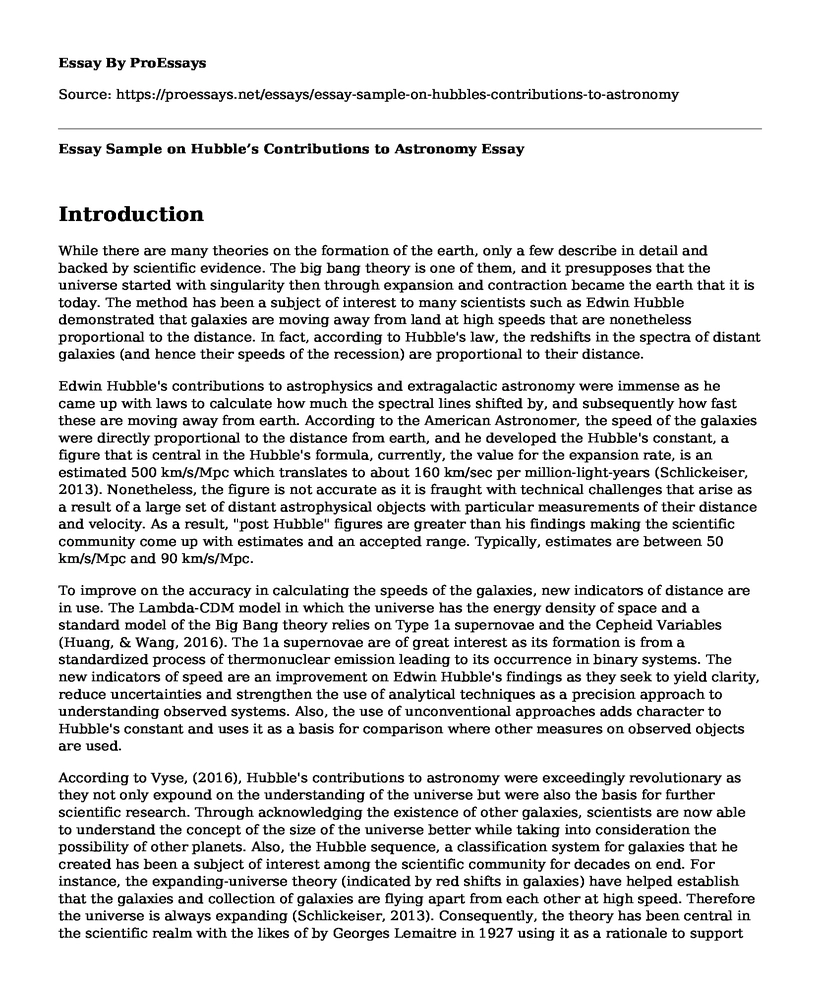Introduction
While there are many theories on the formation of the earth, only a few describe in detail and backed by scientific evidence. The big bang theory is one of them, and it presupposes that the universe started with singularity then through expansion and contraction became the earth that it is today. The method has been a subject of interest to many scientists such as Edwin Hubble demonstrated that galaxies are moving away from land at high speeds that are nonetheless proportional to the distance. In fact, according to Hubble's law, the redshifts in the spectra of distant galaxies (and hence their speeds of the recession) are proportional to their distance.
Edwin Hubble's contributions to astrophysics and extragalactic astronomy were immense as he came up with laws to calculate how much the spectral lines shifted by, and subsequently how fast these are moving away from earth. According to the American Astronomer, the speed of the galaxies were directly proportional to the distance from earth, and he developed the Hubble's constant, a figure that is central in the Hubble's formula, currently, the value for the expansion rate, is an estimated 500 km/s/Mpc which translates to about 160 km/sec per million-light-years (Schlickeiser, 2013). Nonetheless, the figure is not accurate as it is fraught with technical challenges that arise as a result of a large set of distant astrophysical objects with particular measurements of their distance and velocity. As a result, "post Hubble" figures are greater than his findings making the scientific community come up with estimates and an accepted range. Typically, estimates are between 50 km/s/Mpc and 90 km/s/Mpc.
To improve on the accuracy in calculating the speeds of the galaxies, new indicators of distance are in use. The Lambda-CDM model in which the universe has the energy density of space and a standard model of the Big Bang theory relies on Type 1a supernovae and the Cepheid Variables (Huang, & Wang, 2016). The 1a supernovae are of great interest as its formation is from a standardized process of thermonuclear emission leading to its occurrence in binary systems. The new indicators of speed are an improvement on Edwin Hubble's findings as they seek to yield clarity, reduce uncertainties and strengthen the use of analytical techniques as a precision approach to understanding observed systems. Also, the use of unconventional approaches adds character to Hubble's constant and uses it as a basis for comparison where other measures on observed objects are used.
According to Vyse, (2016), Hubble's contributions to astronomy were exceedingly revolutionary as they not only expound on the understanding of the universe but were also the basis for further scientific research. Through acknowledging the existence of other galaxies, scientists are now able to understand the concept of the size of the universe better while taking into consideration the possibility of other planets. Also, the Hubble sequence, a classification system for galaxies that he created has been a subject of interest among the scientific community for decades on end. For instance, the expanding-universe theory (indicated by red shifts in galaxies) have helped establish that the galaxies and collection of galaxies are flying apart from each other at high speed. Therefore the universe is always expanding (Schlickeiser, 2013). Consequently, the theory has been central in the scientific realm with the likes of by Georges Lemaitre in 1927 using it as a rationale to support the Big Bang Theory.
Reference
Huang, Q. G., & Wang, K. (2016). How the dark energy can reconcile Planck with local determination of the Hubble constant. The European Physical Journal C, 76(9), 506.
Kim, S. W., Nishimura, J., & Tsuchiya, A. (2012). Expanding universe as a classical solution in the Lorentzian matrix model for nonperturbative superstring theory. Physical Review D, 86(2), 027901.
Schlickeiser, R. (2013). Cosmic ray astrophysics. Springer Science & Business Media. Vyse, S. (2016). Why Are Millennials Turning to Astrology?. Skeptical Inquirer.
Cite this page
Essay Sample on Hubble's Contributions to Astronomy. (2022, Dec 05). Retrieved from https://proessays.net/essays/essay-sample-on-hubbles-contributions-to-astronomy
If you are the original author of this essay and no longer wish to have it published on the ProEssays website, please click below to request its removal:
- Dissolved Oxygen (D.O.) Case Study Example
- Galileo Theories and Experiments Essay
- Catalyst Paper Example
- South Africa's History, Demography, Geography and Economy Essay
- Overview of the Protein Molecule Paper Example
- Keplers Law - Essay Sample
- Essay Example on Force: The Key to Electric Power Generation







